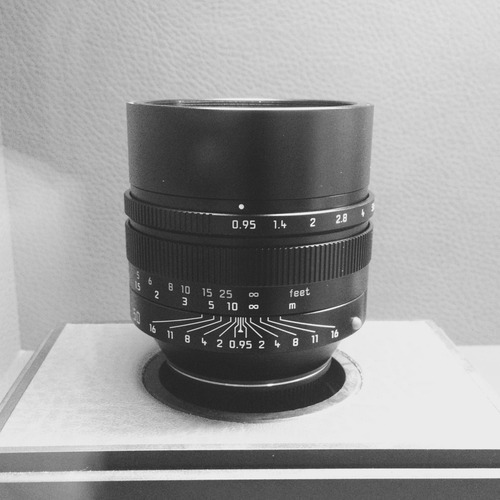I’ve been in the market for an enthusiast compact for a while now. I had my eyes set on the RX100mk3, but then out of nowhere, Panasonic announced the LX100. 4/3 sensor? check. Manual-ish controls? check. Fast autofocus? check. Built in EVF? check. Small size? check. I couldn’t resist, so as soon as the first couple reviews came out, I picked one up for myself. Below are my impressions after about two months of ownership.
Image Quality
Overall, the image quality is great. The sensor is on par with any of the other 4/3 sensors out there. Actually, I suspect most of the modern m43 bodies are based on the same Panasonic sensor (E-M1, GX7, GH4, LX100). While the output is a little different from my EM-1, in terms of overall quality, dynamic range, etc., it goes toe-to-toe with the EM1. Not terribly surprising given the shared sensor.
One thing that immediately turned me off was the default JPEG rendering. I think I’ve been spoiled by the E-M1’s JPEG rendering over the past year or so, but the LX100’s default JPEG setting is pretty terrible. Crappy noise reduction and what looks to me like toy-ish colors. At minimum you have to turn the JPEG noise reduction setting waaaay down. For the most part, I avoid it.
People often make fun of the filters on the camera, but I personally like them. Yes, you can re-create the effects in Lightroom, but it may take you some time. I like having them right on the camera, and especially being able to preview the shot in the selected style. I like Panasonic’s “Dynamic Monochrome” more than the Olympus equivalent, but I like Olympus’s retro style more than Panasonic’s. Go figure.
Lens
I think this was the big surprise for me. For my E-M1, I only have primes. I use the super-sharp Leica 25mm/1.4, the Olympus 45mm/1.8 and on occasion the original 20mm/1.7 — all three top-notch lenses.
As I started to shoot with the LX100, I tried to manage my own expectations. This is a compact zoom, with relatively large aperture. There’s no way it’s going to compete with the best primes for the system. I had read a few of the reviews talking about how corner sharpness suffered at some focal lengths.
But this lens has surpassed all my expectations. Yes, I bet if I peep, I can see some of the corner fall off, but the center is damn sharp. In fact, the Leica 25mm prime is only sharper if you really stop it down to it’s optimum f/4. For something so small and convenient, this is an awesome result. The net of it is that I can do most of my shooting without really worrying about the lens sharpness.
The long end of the zoom gets you about 75mm equivalent. While useful at times, I find 75mm to be a bit of an odd length and not that useful. If I had the choice, I would give up the 50-75mm part of the range for a smaller lens or wider aperture.
Speaking of aperture, one disappointment is that the maximum aperture decreases pretty rapidly as you zoom in. I really like to shoot at 35mm, and at that length, max aperture is f/2.3, which means you’ve lost almost a full stop from it’s maximum 1.7. f/2.3 means that I need ISO6400 to capture my kids at 1/160 indoors, which gives you a bit of grain. At 50mm equivalent, it’s down to f/2.7. This is where the Leica 25/1.4 still comes in
handy.
Size
Of course the whole point of this thing is the small size. If you’re coming from a bigger m43 body or even larger system, the size does not disappoint. It will fit most large coat pockets, and will take up no space in any kind of bag. That being said, it is definitely not pants-pocketable. The lens barrel just sticks out too much, even when collapsed.
When I realized this, I initially hesitated. I really wanted rx100-levels of portability with the 4/3 sensor capability and better controls. However, as I’ve taken this camera anywhere, I’ve come to realize that it’s generally so small and light that I can just use the included strap and string it over my shoulder and forget about it. The camera is so small and light that it doesn’t get in the way of most light activities. For example, after a day at the park, when I get back in the car to drive home, the E-M1 would have to come off for me to drive. With the LX100, I just adjust the strap so that I wear it diagonally and then just sit down and drive. Physical Controls
The other big draw of the LX100 are the full set of external dials for all the major controls (shutter speed dial, aperture ring around the lens barrel, EV comp dial). In general, I love having these and they make shooting with the camera lots of fun. Interestingly, when I tried a similar scheme over a year ago with the Fuji X-E2, I didn’t like it as much. But since then, I’ve learned to use the manual mode on my E-M1 a lot more. So I think this type of control scheme really requires a level of maturity with camera operation. If you’re still learning the ropes, the dials are going to require you to up your game and really think about all the parameters.
Even then, I still sometimes get tripped up by the EV comp dial. On a more DSLR-like control scheme like the E-M1, switching from shutter to aperture priority typically resents the EV comp value. No so on a LX100 (or any other body that employs similar control). Once you dial in -2 EV, you had better remember to switch it back when you’re on to the next shot. Other times, the EV comp dial gets knocked while the camera is in my bag, and next thing I know I’ve shot a few shots at -1 EV. Over time I’ve learned to be more vigilant about the dial, but still it is a source of stress.
The other slightly odd decision was to make the focus ring by default adjust the shutter speed. This is configurable in the menus but the behavior is really confusing until you notice it. It’s very easy to move the focus right every so slightly, especially when you’re going for the manual aperture dial, and by doing so, you’ll adjust the shutter speed a little bit off of it’s dial setting. In general, for a given shutter speed dial
setting, you can fine-tune it using either the manual focus ring, or the rear wheel by up to 1 stop in each direction. While this is handy in that you can set “in-between” shutter speeds like 1/160, it also means that the current setting may not be exactly the same as the dial, which means you have to look at the screen if you want to be sure.
Autofocus
For the most part, the autofocus is amazingly fast. I was really surprised by this. I’ve never used a compact camera that focused this fast. In most cases, it’s faster than my E-M1 with 25mm/1.4 (not the fastest lens in terms of focusing). It also retains it’s AF speed in low light better than the E-M1. Basically no complaints here.
One of my torture tests for AF is to take shots of my kids as they go back and forth on the swings in the park. LX100 can handle this no problem. Just set the shutter to 1/1000, S-AF and fire away.
I haven’t done too much with the C-AF. In my limited use, it seems OK, but not amazing. I suspect it’s probably on par with the GH4. Panasonic’s face detection works quite well, and I prefer the UI to Olympus’. However, the one thing I’ve gotten used to on the Olympus is the ability to set it up so that by default you have your selected focus point that gets overridden automatically when a face is detected. On the LX100 (as other Panasonic camera), face detection is it’s own mode. So if you want to switch between Face detection and single point focus, it takes some menu navigation to do it.
Other Minor Observations and Nit-picking
One very nice feature is the nearly silent leaf shutter. I’ve played a bit with the Fuji X100s, but this shutter is even more silent. So much so that when you first start laying with the camera, you can take a shot w/o realizing it. I’ve seen this happen to multiple people I’ve handed the camera to. They push the shutter, they see the screen blank for a second, but because I had auto image review turned off, they’re not sure if they took anything. The shutter barely makes a sound and registers no tangible vibration. The ultimate sealth camera.
One disappointment is a lack of built-in flash. There’s a small flash in the box, which is usable in a desperate situation, but I much prefer a built-in bounce-able flash like the one found on the a6000.
It’s very hard to chimp your RAW files on this camera. While this problem exists on any
cameras, it’s particularly bad on the LX100. The jpeg preview that is rendered when you take a shot in RAW is way too low-res. You zoom in two levels to 4x, and that’s the limit. Any more and you just see stretched blur. The main problem is that the resolution is not enough to be able to confirm focus. I just have pray that I got it and check on the computer later.
I found the WI-FI feature ok when it works, but have had tons of problems getting it to connect at all.. especially when I’m out and about with no wifi networks around. Perhaps an issue on the iphone side, but it’s bad enough that I haven’t been able to use the feature much, even in cases where I really wanted it. Perhaps I’m just doing something wrong, but I’ve never had this much trouble from any of the apps from any of the brands.
I think one of the persistent complaints about the LX series has been the lens cap. The LX100 is no different. Included in the box is a standard snap on cap with a short leash chord you can use to attach it to the body. There’s just something about it that feels super onerous when you just want to get a quick shot. There is a petaled lens hood, but availability of the black one in the US seems poor, even months after launch. I may just go with a UV filter, but haven’t decided yet.
Other reviews have noted this as well, but on startup, it takes a long time for the lens to fully extend. It’s sad because the camera feels so snappy once it’s ready to go, but turning it on feels sloooow. On a related note, if you turn it on, and then go into playback mode and start looking at some pictures, the lens retracts. To get it to extend again, you have to half-press the shutter, but then again it takes it’s time to fully extend again. Kind of annoying when you’re out and you take a few shots of something, then want to review them in playback, and next thing you know the lens is back in so when you’re ready to take some more shots there’s a delay.
I haven’t seen it mentioned anywhere, but the default luminance setting of the rear LCD seems really off. Images look as if you did a +2EV exposure adjustment in Lightroom. You can tone it down in the menus, but this confused me initially. In combination with the fact that I often didn’t realize I had knocked the EV-comp dial to a -1EV position, I underexposed a bunch of shots. I’ve learned to try to keep an eye on the live histogram as much as possible.
Another minor nitpick. When you turn on both the leveling meter and the histogram on the live view, it tends to cover a large part of the image. When I handed the camera off to a friend when it was in this state, she asked me, “where’s the actual picture?” 😦
I haven’t used 4K photo mode that much, but when I have, it’s been pretty nice. It’s certainly a very interesting way to shoot, and I definitely plan to play with it more in the future. For the scenarios I tried it in, it seemed highly dependent on the C-AF performance during video. In other words, you get 30 frames per second to choose from, but that doesn’t mean anything if your subject is moving out of the focus plane and the AF can’t keep up. Also, the in-camera UI to browse the video and pick out frames is kind of clunky and slow. It will work in a pinch, but it’s probably better to do it back on the computer, in which case, I’m not totally sure what software I’m supposed to use.
Lens stabilization seems reasonable. It’s not anywhere close to the E-M1, but it does let you get down to the 1/20 shutter speed or so w/o much issue.
Bottom Line
In most of my day-to-day, outdoor situations, the LX100 has replaced my E-M1 as my go-to camera. It’s smaller enough than the E-M1 that I will take it out in more situations. So much so that debating getting something bigger as my “big gun” (D750, A7ii, etc.)
I still turn to E-M1 + 25mm f/1.4 for indoor situations (mostly because of max aperture). I’d prefer if this combo focused as quickly as LX100 though. But those are often situations where I don’t need as much portability, so it’s starting to make sense to differentiate further and get something slightly larger for those situations.









